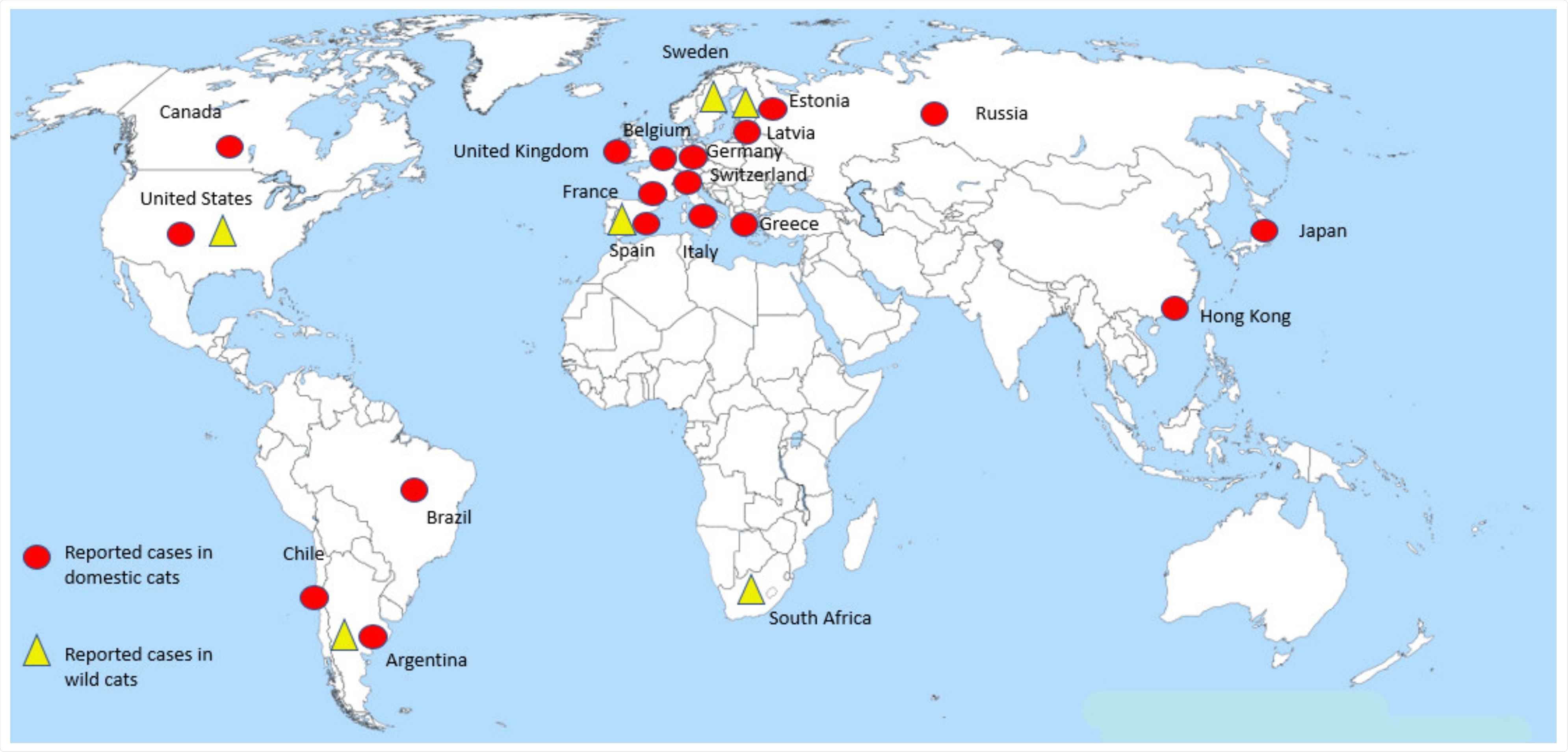Coronaviruses are RNA viruses that infect both animals as well as humans. The current coronavirus disease 2019 (COVID-19) pandemic, caused by severe acute respiratory syndrome coronavirus-2 (SARS-CoV-2), has claimed more than 4 million lives globally.
This virus has been described as a zoonotic virus and might have originated from bats with an unknown intermediate host. Scientists have suggested a few potential intermediate hosts, such as pangolins, rodents, and bats. However, the transmission dynamics associated with the jumping of the virus between different species, including humans, are not clear.

Determination of wide-ranging species that can be infected by SARS-CoV-2
Several studies have been conducted to identify the wide range of species that can be infected by SARS-CoV-2. Researchers have determined the affinity of angiotensin-converting enzyme 2 (ACE2) from different animal species for the SARS-CoV-2 spike protein (S). Previous research has found that susceptibility to infection varies from one species to another. Higher susceptibility to SARS-CoV-2 was found, in cats and members of the family Felidae, because of the high affinity of the virus to the ACE2 orthologue. However, dogs are found to be less susceptible to the virus due to the lower expression of ACE2 in the respiratory tract cells.
Earlier studies have reported that different viruses from the family Coronaviridae can infect domestic and wild felines. These viruses are classified as feline coronaviruses (FCoVs). These studies have shown that felines infected with coronavirus can develop mild enteric disease (feline enteric coronaviruses; FECV) or viruses can undergo mutations and create feline infectious peritonitis virus (FIPV). FIPV is more infectious and can cause severe disease that can lead to death.
Importance of studying clinical signs of SARS-CoV-2 infections in felines
Typically, pet cats share a close relationship with their owners. Also, felines in the zoo or wildlife center are very much connected with their keeper. Hence, an increasing number of reports of feline infection with SARS-CoV-2 has created the need to understand the clinical implications of SARS-CoV-2 infections in felines.
Now, a new systematic review has been published in the journal Animals that focuses on the clinical symptoms in felines diagnosed with SARS-CoV-2 worldwide.

Scientists conducting this review implemented different search strategies for obtaining research associated with felids diagnosed with SARS-CoV-2 infections from the existing databases and found 19 articles and 65 detailed reports from official sources.
The World Organisation for Animal Health (OIE) website was the primary official source of information. Here the authors found evidence of 76 domestic cats in the US with confirmed SARS-CoV-2 infection. However, only 22 documented relevant information regarding the occurrence or absence of clinical signs among these cases.
A global distribution pattern was observed concerning felids infected with SARS-CoV-2. However, most cases were reported in the Americas and Europe. Such an observation aligns with the fact that these regions were massively hit by COVID-19 infection. Limited studies are available on felids infection from other badly affected areas, such as India and Brazil.
Clinical symptoms of SARS-CoV-2 infection in felines
Both domestic, as well as wild felines, have been reported to be infected with SARS-CoV-2. The following section describes the clinical symptoms associated with the disease.
Domestic cats
In 54% of the cases, the cats were asymptomatic. They were identified because their owners were diagnosed with COVID-19. So the researchers, out of curiosity, screened the cats for the disease and interestingly found them to be COVID-19 positive.
In the remaining 46% of the cases, the cats showed clinical symptoms associated with COVID-19 infection. Among these infected felids, 26 survived, and six died owing to the infection.
One of the reports indicated that cats developed shortness of breath and tachypnea. They were also diagnosed with hypertrophic cardiomyopathy and Mycoplasma haemofelis infection.
One of the cats that died from the disease showed clinical symptoms such as nasal discharge and neurological signs such as head pressing. The necropsy symptoms indicated that the cat developed bacterial meningoencephalitis.
The cats infected with COVID-19 were also diagnosed with anemia, thrombocytopenia, and hypertrophic cardiomyopathy. An ultrasound examination showed a bronchointerstitial pattern in the lung.
Additionally, tissue analysis revealed signs of severe pulmonary edema, hemorrhage, and congestion in the infected cats. Some of the other symptoms, such as vomiting, mouth ulcers, and diarrhea, were also reported.
Wild cats
Several cases of SARS-CoV-2 infection in wild felines have been reported around the world. Scientists have revealed that members of the genus Panthera (e.g., tigers, lions, and snow leopards) and genus Puma (e.g., Puma concolor) have been infected by the virus.
Infection of wild felines with SARS-CoV-2 is associated with human-animal transmission, where the staff responsible for caring for these animals were COVID-19 positive and might have transmitted the disease to the animals.
All animals that tested positive for SARS-CoV-2 (except for one asymptomatic tiger) showed clinical signs such as coughing and wheezing. In addition to the respiratory symptoms, other symptoms such as lack of appetite and lethargy have also been reported.

Conclusions
Experimental studies have shown that cats previously infected with SARS-CoV-2 can be re-infected with the virus. However, infected cats could not transmit the infection to another healthy cat.
Histopathological studies revealed that SARS-CoV-2 infection might cause lesions in the nasal and tracheal mucosa and lung parenchyma. This may be because virus replication occurs in these tissues. The histopathological lesions showed suppurative lymphoplasmacytic rhinitis in nasal turbinates and lymphoplasmacytic tracheitis and alveolar histiocytosis.
The authors conclude, “Given the current complex situation which has arisen due to the COVID-19 pandemic and the emergence of viruses with zoonotic potential, it is of paramount importance to establish both national and international surveillance systems to closely monitor the development and occurrence of SARS-CoV-2 and other agents of public health relevance in animals and its possible “spillover” to humans and the possible “spill-back”—causing public health concerns—highlighting that all efforts should be focused on the concept and implementation of “One Health/One Medicine” to understand how aspects involving the environment, animals, and humans could contribute substantially to the control of epidemics in the near future.”
- Giraldo-Ramirez, S. et al. (2021). SARS-CoV-2 Clinical Outcome in Domestic and Wild Cats: A Systematic Review. Animals. 11 (7). p.p. 2056. Available from: http://dx.doi.org/10.3390/ani11072056, https://www.mdpi.com/2076-2615/11/7/2056
Posted in: Medical Science News | Medical Research News | Disease/Infection News
Tags: ACE2, Anemia, Angiotensin, Angiotensin-Converting Enzyme 2, Cardiomyopathy, Coronavirus, Coronavirus Disease COVID-19, Coughing, Diarrhea, Edema, Enzyme, Hypertrophic Cardiomyopathy, Lethargy, Medicine, Mycoplasma, Pandemic, Peritonitis, Protein, Public Health, Pulmonary Edema, Research, Respiratory, Rhinitis, RNA, SARS, SARS-CoV-2, Severe Acute Respiratory, Severe Acute Respiratory Syndrome, Spike Protein, Syndrome, Thrombocytopenia, Ultrasound, Virus, Vomiting

Written by
Dr. Priyom Bose
Priyom holds a Ph.D. in Plant Biology and Biotechnology from the University of Madras, India. She is an active researcher and an experienced science writer. Priyom has also co-authored several original research articles that have been published in reputed peer-reviewed journals. She is also an avid reader and an amateur photographer.
Source: Read Full Article
